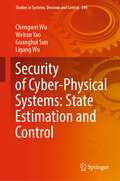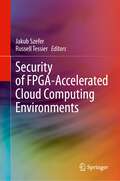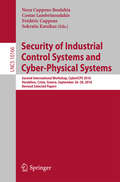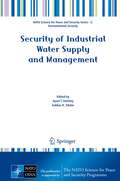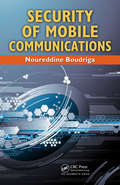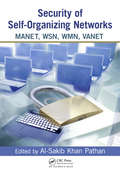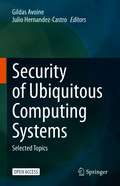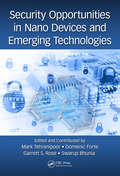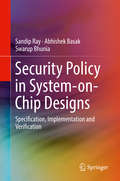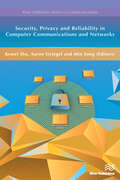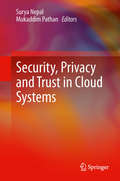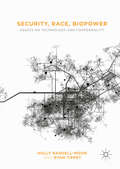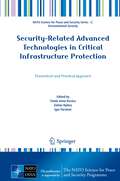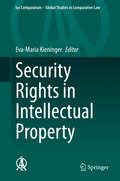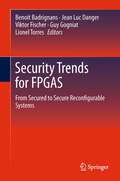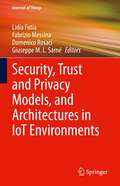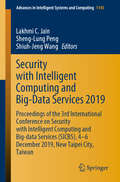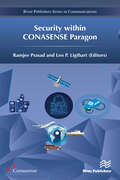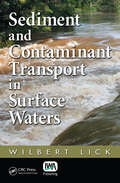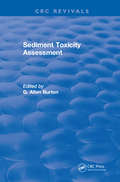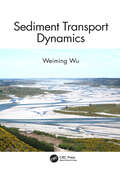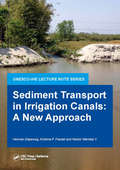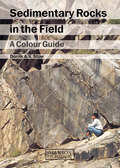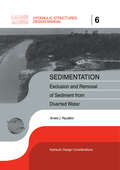- Table View
- List View
Security of Cyber-Physical Systems: State Estimation and Control (Studies in Systems, Decision and Control #396)
by Chengwei Wu Weiran Yao Guanghui Sun Ligang WuThis book analyzes the secure problems of cyber-physical systems from both the adversary and defender sides. Targeting the challenging security problems of cyber-physical systems under malicious attacks, this book presents some recent novel secure state estimation and control algorithms, in which moving target defense scheme, zero-sum game-theoretical approach, reinforcement learning, neural networks, and intelligent control are adopted. Readers will find not only the valuable secure state estimation and control schemes combined with the approaches aforementioned, but also some vital conclusions for securing cyber-physical systems, for example, the critical value of allowed attack probability, the maximum number of sensors to be attacked, etc. The book also provides practical applications, example of which are unmanned aerial vehicles, interruptible power system, and robot arm to validate the proposed secure algorithms. Given its scope, it offers a valuable resource for undergraduate and graduate students, academics, scientists, and engineers who are working in this field.
Security of FPGA-Accelerated Cloud Computing Environments
by Jakub Szefer Russell TessierThis book addresses security of FPGA-accelerated cloud computing environments. It presents a comprehensive review of the state-of-the-art in security threats as well as defenses. The book further presents design principles to help in the evaluation and designs of cloud-based FPGA deployments which are secure from information leaks and potential attacks.
Security of Industrial Control Systems and Cyber-Physical Systems
by Nora Cuppens-Boulahia Costas Lambrinoudakis Frédéric Cuppens Sokratis KatsikasThis book constitutes the refereed proceedings of the First Conference on Cybersecurity of Industrial Control Systems, CyberICS 2015, and the First Workshop on the Security of Cyber Physical Systems, WOS-CPS 2015, held in Vienna, Austria, in September 2015 in conjunction with ESORICS 2015, the 20th annual European Symposium on Research in Computer Security. The 6 revised full papers and 2 short papers of CyberICS 2015 presented together with 3 revised full papers of WOS-CPS 2015 were carefully reviewed and selected from 28 initial submissions. CyberICS 2015 focuses on topics covering ICSs, including cyber protection and cyber defense of SCADA systems, plant control systems, engineering workstations, substation equipment, programmable logic controllers, PLCs, and other industrial control system. WOS-CPS 2015 deals with the Security of Cyber Physical Systems, that exist everywhere around us, and range in size, complexity and criticality, from embedded systems used in smart vehicles, to SCADA systems in smart grids to control systems in water distribution systems, to smart transportation systems etc.
Security of Industrial Water Supply and Management
by Subhas K. Sikdar Aysel T. AtimtayOver time, the increased use of fresh water for agriculture and industry together with contamination from discharges of pollutants, mean that ever more areas of the planet are becoming water-stressed. Because of the competing needs of communities and industry for fresh water, industry will be challenged to meet its growing demands for water, which is essential for producing the goods and services that would boost human welfare. Thus industry will need to learn how to cost-effectively purify and recycle its wastewater for reuse, ultimately approaching a net zero-discharge condition. The chapters in this book, written by international experts, treat the technical issues of such treatment and water management, and also provide guidance on technologies, either existing or in development, that can potentially achieve the goal of recycle-reuse. The book will serve as a useful reference for academics, government and industry professionals alike.
Security of Mobile Communications
by Noureddine BoudrigaThe explosive demand for mobile communications is driving the development of wireless technology at an unprecedented pace. Unfortunately, this exceptional growth is also giving rise to a myriad of security issues at all levels-from subscriber to network operator to service provider. Providing technicians and designers with a critical and comprehens
Security of Self-Organizing Networks: MANET, WSN, WMN, VANET
by AI-Sakib Khan PathanReflecting recent advancements, Security of Self-Organizing Networks: MANET, WSN, WMN, VANET explores wireless network security from all angles. It begins with a review of fundamental security topics and often-used terms to set the foundation for the following chapters. Examining critical security issues in a range of wireless networks, the bo
Security of Ubiquitous Computing Systems: Selected Topics
by Gildas Avoine Julio Hernandez-CastroThe chapters in this open access book arise out of the EU Cost Action project Cryptacus, the objective of which was to improve and adapt existent cryptanalysis methodologies and tools to the ubiquitous computing framework. The cryptanalysis implemented lies along four axes: cryptographic models, cryptanalysis of building blocks, hardware and software security engineering, and security assessment of real-world systems.The authors are top-class researchers in security and cryptography, and the contributions are of value to researchers and practitioners in these domains.This book is open access under a CC BY license.
Security Opportunities in Nano Devices and Emerging Technologies
by Mark Tehranipoor, Domenic Forte, Garrett S. Rose and Swarup BhuniaThe research community lacks both the capability to explain the effectiveness of existing techniques and the metrics to predict the security properties and vulnerabilities of the next generation of nano-devices and systems. This book provides in-depth viewpoints on security issues and explains how nano devices and their unique properties can address the opportunities and challenges of the security community, manufacturers, system integrators, and end users. This book elevates security as a fundamental design parameter, transforming the way new nano-devices are developed. Part 1 focuses on nano devices and building security primitives. Part 2 focuses on emerging technologies and integrations.
Security Policy in System-on-Chip Designs: Specification, Implementation and Verification
by Sandip Ray Abhishek Basak Swarup BhuniaThis book offers readers comprehensive coverage of security policy specification using new policy languages, implementation of security policies in Systems-on-Chip (SoC) designs – current industrial practice, as well as emerging approaches to architecting SoC security policies and security policy verification. The authors focus on a promising security architecture for implementing security policies, which satisfies the goals of flexibility, verification, and upgradability from the ground up, including a plug-and-play hardware block in which all policy implementations are enclosed. Using this architecture, they discuss the ramifications of designing SoC security policies, including effects on non-functional properties (power/performance), debug, validation, and upgrade. The authors also describe a systematic approach for “hardware patching”, i.e., upgrading hardware implementations of security requirements safely, reliably, and securely in the field, meeting a critical need for diverse Internet of Things (IoT) devices.Provides comprehensive coverage of SoC security requirements, security policies, languages, and security architecture for current and emerging computing devices;Explodes myths and ambiguities in SoC security policy implementations, and provide a rigorous treatment of the subject;Demonstrates a rigorous, step-by-step approach to developing a diversity of SoC security policies;Introduces a rigorous, disciplined approach to “hardware patching”, i.e., secure technique for updating hardware functionality of computing devices in-field;Includes discussion of current and emerging approaches for security policy verification.
Security, Privacy and Reliability in Computer Communications and Networks
by Kewei Sha Aaron Striegel Min SongFuture communication networks aim to build an intelligent and efficient living environment by connecting a variety of heterogeneous networks to fulfill complicated tasks. These communication networks bring significant challenges in building secure and reliable communication networks to address the numerous threat and privacy concerns. New research technologies are essential to preserve privacy, prevent attacks, and achieve the requisite reliability. Security, Privacy and Reliability in Computer Communications and Networks studies and presents recent advances reflecting the state-of-the-art research achievements in novel cryptographic algorithm design, intrusion detection, privacy preserving techniques and reliable routing protocols. Technical topics discussed in the book include: Vulnerabilities and Intrusion DetectionCryptographic Algorithms and EvaluationPrivacyReliable Routing ProtocolsThis book is ideal for personnel in computer communication and networking industries as well as academic staff and collegial, master, Ph.D. students in computer science, computer engineering, cyber security, information insurance and telecommunication systems.
Security, Privacy and Trust in Cloud Systems
by Mukaddim Pathan Surya NepalThe book compiles technologies for enhancing and provisioning security, privacy and trust in cloud systems based on Quality of Service requirements. It is a timely contribution to a field that is gaining considerable research interest, momentum, and provides a comprehensive coverage of technologies related to cloud security, privacy and trust. In particular, the book includes - Cloud security fundamentals and related technologies to-date, with a comprehensive coverage of evolution, current landscape, and future roadmap. - A smooth organization with introductory, advanced and specialist content, i.e. from basics of security, privacy and trust in cloud systems, to advanced cartographic techniques, case studies covering both social and technological aspects, and advanced platforms. - Case studies written by professionals and/or industrial researchers. - Inclusion of a section on Cloud security and eGovernance tutorial that can be used for knowledge transfer and teaching purpose. - Identification of open research issues to help practitioners and researchers. The book is a timely topic for readers, including practicing engineers and academics, in the domains related to the engineering, science, and art of building networks and networked applications. Specifically, upon reading this book, audiences will perceive the following benefits: 1. Learn the state-of-the-art in research and development on cloud security, privacy and trust. 2. Obtain a future roadmap by learning open research issues. 3. Gather the background knowledge to tackle key problems, whose solutions will enhance the evolution of next-generation secure cloud systems.
Security, Race, Biopower
by Ryan Tippet Holly Randell-MoonThis book explores how technologies of media, medicine, law and governance enable and constrain the mobility of bodies within geographies of space and race. Each chapter describes and critiques the ways in which contemporary technologies produce citizens according to their statistical risk or value in an atmosphere of generalised security, both in relation to categories of race, and within the new possibilities for locating and managing bodies in space. The topics covered include: drone warfare, the global distribution of HIV-prevention drugs, racial profiling in airports, Indigenous sovereignty, consumer lifestyle apps and their ecological and labour costs, and anti-aging therapies. Security, Race, Biopower makes innovative contributions to multiple disciplines and identifies emerging social and political concerns with security, race and risk that invite further scholarly attention. It will be of great interest to scholars and students in disciplinary fields including Media and Communication, Geography, Science and Technology Studies, Political Science and Sociology.
Security-Related Advanced Technologies in Critical Infrastructure Protection: Theoretical and Practical Approach (NATO Science for Peace and Security Series C: Environmental Security)
by Tünde Anna Kovács Zoltán Nyikes Igor FürstnerThis book collects the latest research results on security-related advanced technologies. The chapters contain relevant and interesting topics from numerous research. Data science and artificial intelligence research nowadays one of the most important topics for the industry and the security sectors. The autonomy and counter-autonomy research topic are also very interesting. Autonomous cars have become a part of the common days, but their safe and secure application is not assured. The research results in this field want to support and assure safe and secure autonomous applications in our quotidian life. Also, the safe and secure robotics in the industries and the defence assure a high standard of living and the given research results in this area can use to increase it. The researchers work on it and publish the results that can be interesting for the other researchers and the innovators, but also the industrial part members. The researchers work on it and publish the results that can be interesting for the other researchers and the innovators, but also the industrial part members. Communication is a part of our life, but the communication systems mesh all around the world. Communication is the basis of modern life because without it life stop. One other interesting and very important research area is the material sciences. Virtual life cannot exist without hardware and materials. The new technical applications require new materials, that can suffice the mechanical and physical, chemical properties demand. Nowadays a common requirement of the materials the high strength and lightweight. Researchers want to serve the industrial requests and innovate new composite materials or increase the properties of the material through a new technological process. The authors publish the latest results of the security-related research area including the newest innovations and technologies which rise the interest of the defence and the modern industries even the interest of other researchers.
Security Rights in Intellectual Property (Ius Comparatum - Global Studies in Comparative Law #45)
by Eva-Maria KieningerThis book discusses the main legal and economic challenges to the creation and enforcement of security rights in intellectual property and explores possible avenues of reform, such as more specific rules for security in IP rights and better coordination between intellectual property law and secured transactions law. In the context of business financing, intellectual property rights are still only reluctantly used as collateral, and on a small scale. If they are used at all, it is mostly done in the form of a floating charge or some other “all-asset” security right. The only sector in which security rights in intellectual property play a major role, at least in some jurisdictions, is the financing of movies. On the other hand, it is virtually undisputed that security rights in intellectual property could be economically valuable, or even crucial, for small and medium-sized enterprises – especially for start-ups, which are often very innovative and creative, but have limited access to corporate financing and must rely on capital markets (securitization, capital market). Therefore, they need to secure bank loans, yet lack their own traditional collateral, such as land.
Security Trends for FPGAS
by Jean Luc Danger Benoit Badrignans Guy Gogniat Viktor Fischer Lionel TorresIn Security Trends for FPGA's the authors present an analysis of current threats against embedded systems and especially FPGAs. They discuss about requirements according to the FIPS standard in order to build a secure system. This point is of paramount importance as it guarantees the level of security of a system. Also highlighted are current vulnerabilities of FPGAs at all the levels of the security pyramid. It is essential from a design point of view to be aware of all the levels in order to provide a comprehensive solution. The strength of a system is defined by its weakest point; there is no reason to enhance other protection means, if the weakest point remains untreated. Many severe attacks have considered this weakness in order not to face brute force attack complexity. Several solutions are proposed in Security Trends for FPGA's especially at the logical, architecture and system levels in order to provide a global solution.
Security, Trust and Privacy Models, and Architectures in IoT Environments (Internet of Things)
by Lidia Fotia Fabrizio Messina Domenico Rosaci Giuseppe M. L. SarnéThis book is dedicated to the issues of security, trust and privacy models, and architectures in IoT environments. The authors aim to capture the latest research and contributions from academy, industry, and other stakeholders on new security models, architectures, protocols, and standards for ensuring security, privacy, and trustworthiness to IoT systems. The authors discuss the convergence of IoT, software agents, and edge computing to introduce social features into IoT systems, combining trustworthiness and reputation information collected by agents at the edge with security and privacy mechanisms. They also cover experimental and simulated campaigns that evaluate strategies to improve the security and privacy of the IoT world, and at the same time the ability to prevent and deter deceptive behaviors. The book is relevant for researchers, professionals, academics, and students.
Security with Intelligent Computing and Big-Data Services 2019: Proceedings of the 3rd International Conference on Security with Intelligent Computing and Big-data Services (SICBS), 4–6 December 2019, New Taipei City, Taiwan (Advances in Intelligent Systems and Computing #1145)
by Lakhmi C. Jain Sheng-Lung Peng Shiuh-Jeng WangThis book aims to attract researchers and practitioners who are working in Information Technology and Computer Science. This edited book is about basics and high level concepts regarding Blockchain Technology and Application, Multimedia Security, Information Processing, Security of Network, Cloud and IoT, Cryptography and Cryptosystem, Learning and Intelligent Computing, Information Hiding. It is becoming increasingly important to develop adaptive, intelligent computing-centric, energy-aware, secure and privacy-aware mechanisms in high performance computing and IoT applications. The book serves as a useful guide for industry persons and also helps beginners to learn things from basic to advance in the area of better computing paradigm. Our aim is intended to provide a platform for researchers, engineers, academicians as well as industrial professionals from all over the world to present their research results in security related areas. We believe that this volume not only presents novel and interesting ideas but also will stimulate interesting discussions from the participants and inspire new ideas.
Security within CONASENSE Paragon
by Ramjee Prasad Leo P. LigthartSecurity within CONASENSE Paragon describes in particular the cyber security issues in the field of Communication, Navigation, Sensing and Services within the broad platform of CTIF Global Capsule (CGC). This covers future technologies and its enablers, smart cities, crowd computing, reliable and secure communication interface, satellite unnamed air vehicles, wireless sensor networks, data analytics and deep learning, remotely piloted aircraft system and public safety, network neutrality, business ecosystem innovation and so on.
Sediment and Contaminant Transport in Surface Waters
by Wilbert LickContaminated bottom sediments and their negative impacts on water quality are a major problem in surface waters throughout the United States as well as in many other parts of the world. Even after elimination of the primary contaminant sources, these bottom sediments will be a main source of contaminants for many years to come. In order to determin
Sediment Toxicity Assessment
by G.Allen BurtonSediment Toxicity Assessment provides the latest information regarding how to evaluate sediment contamination and its effects on aquatic ecosystems. It presents an integrated ecosystem approach by detailing effective assessment methods, considerations, and effects to each major component of marine and freshwater systems, including the benthos, plankton, and fish communities. The approaches emphasize defining habitat conditions (physical and chemical), toxicant bioavailability, factors influencing toxicity (lab and field), biomarkers, acute and chronic toxicity, study design, collection methods, and EPA management strategies. The book also explains how to integrate the assessments.Sediment Toxicity Assessment will be useful to to all environmental managers, environmental scientists, ecotoxicologists, environmental regulators, aquatic ecologists, environmental contractors and consultants, instructors, students, conservation commissions, and environmental activist organizations.
Sediment Transport and Morphodynamics Modelling for Coasts and Shallow Environments
by Vanesa MagarThis reference for engineers, and graduate students covers sediment transport and morphodynamics modelling in nearshore environments. It presents the fundamentals required for understanding the physics and for setting up numerical models. This book covers hydrodynamics of estuarine and coastal environments, properties of seafloor and estuarine composition, and hydroenvironmental interactions; emphasising the inter-relations of small- and large-scale processes, and short- and large-evolution timescales. The focus is, principally, on the application of shallow-water theory, but some surface wave models, and coupling of shallow-water models with surface waves is also discussed to some extent. The guidance on running regional models and the case studies presented are directed to managed realignment, coastal protection, climate change impacts, and offshore renewables. Key features: Gives a balanced review of this rich interdisciplinary area Bridges practical engineering and research Offers both large- and small-scale application Suits graduate students and researchers as well as consulting engineers Vanesa Magar is a senior researcher and associate professor at the Centro de Investigación Científica y de Educación Superior de Ensenada (CICESE) in Baja California, Mexico. She was formerly a researcher and then a lecturer at Plymouth University, UK.
Sediment Transport Dynamics
by Weiming WuThis book focuses on the fundamentals of sediment transport in surface waters. It covers sediment properties, open channel flows, sediment particle settling, incipient motion, bed forms, bed load, suspended load, total load, cohesive sediments, water-sediment two-phase flows, hyperconcentrated flows, debris flows, wave-induced sediment transport, turbidity currents, and physical modeling. Besides the primary context of river sedimentation, this book extensively covers sediment transport under coexisting waves and currents in coasts and estuaries, hyperconcentrated and debris flows in rivers, as well as turbidity currents in lakes, reservoirs, channels, and the ocean. It includes a chapter on the water-sediment two-phase flow theory, which is considered the basis of many sediment transport models. It introduces some special topics have that emerged in recent years, such as the transport of mixed cohesive and noncohesive sediments, biofilm-coated sediments, and infiltrated sand within gravel and cobble beds. The text merges classical and new knowledge of sediment transport from various sources in English and non-English literature and includes important contributions made by many scientists and engineers from all over the world. It balances the breadth, depth, fundamental importance, practical applicability, and future advancement of the covered knowledge, and can be used as a text and reference book. The chapters are arranged in a useful sequence for teaching purposes. Certain homework problems are prepared, which also highlight the important topics for instructors to select. Solutions to homework problems are available from the author by request.
Sediment Transport in Irrigation Canals: A New Approach (IHE Delft Lecture Note Series)
by Herman Depeweg Krishna P. Paudel Néstor Méndez VSediment transport in irrigation canals influences to a great extent the sustainability of an irrigation system. Unwanted erosion or deposition will not only increase maintenance costs, but may also lead to unfair, unreliable and unequitable distribution of irrigation water to the end users. Proper knowledge of the characteristics, including behaviour and transport of sediment will help to design irrigation systems, plan effi cient and reliable water delivery schedules, to have a controlled deposition of sediments, to estimate and arrange maintenance activities, etc. The main aim of these lecture notes is to present a detailed analysis and physical and mathematical descriptions of sediment transport in irrigation canals and to describe the mathematical model SETRIC that predicts the sediment transport, deposition and entrainment rate as function of time and place for various flow conditions and sediment inputs. The model is typically suited for the simulation of sediment transport under the particular conditions of non-wide irrigation canals where the flow and sediment transport are strongly determined by the operation of the flow control structures. The lecture notes will contribute to an improved understanding of the behaviour of sediments in irrigation canals. They will also help to decide on the appropriate design of the system, the water delivery plans, to evaluate design alternatives and to achieve an adequate and reliable water supply to the farmers.
Sedimentary Rocks in the Field: A Colour Guide
by Dorrik A.V. StowIdeas and concepts in sedimentology are changing rapidly but fundamental field work and data collection remain the basis of the science. This book is intended as a guide to the recognition and description of sedimentary rocks in the field. It aims to help the geologist know what to observe and record and how best to interpret this data. The emphasi
Sedimentation: Exclusion and Removal of Sediment from Diverted Water (Iahr Design Manual Ser. #6)
by Arved J. RaudkiviThis monograph provides the practising engineer with a concise overview of the methods of water diversion and exclusion or removal of sediment from the diverted water. The emphasis is on flow features and the associated conveyance of sediments.
